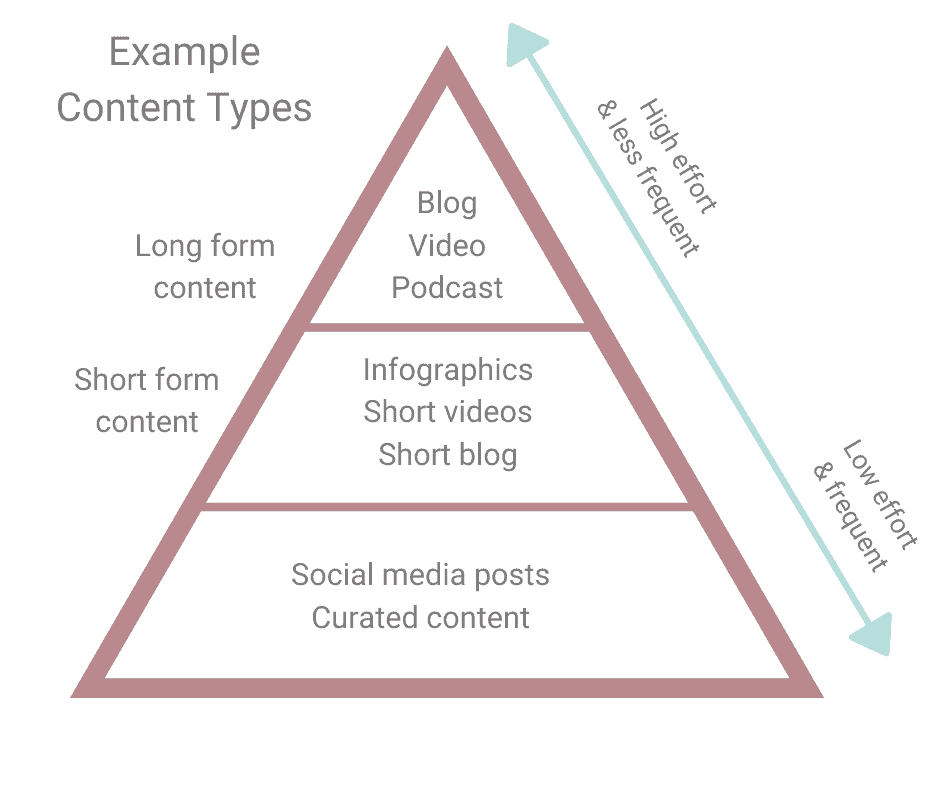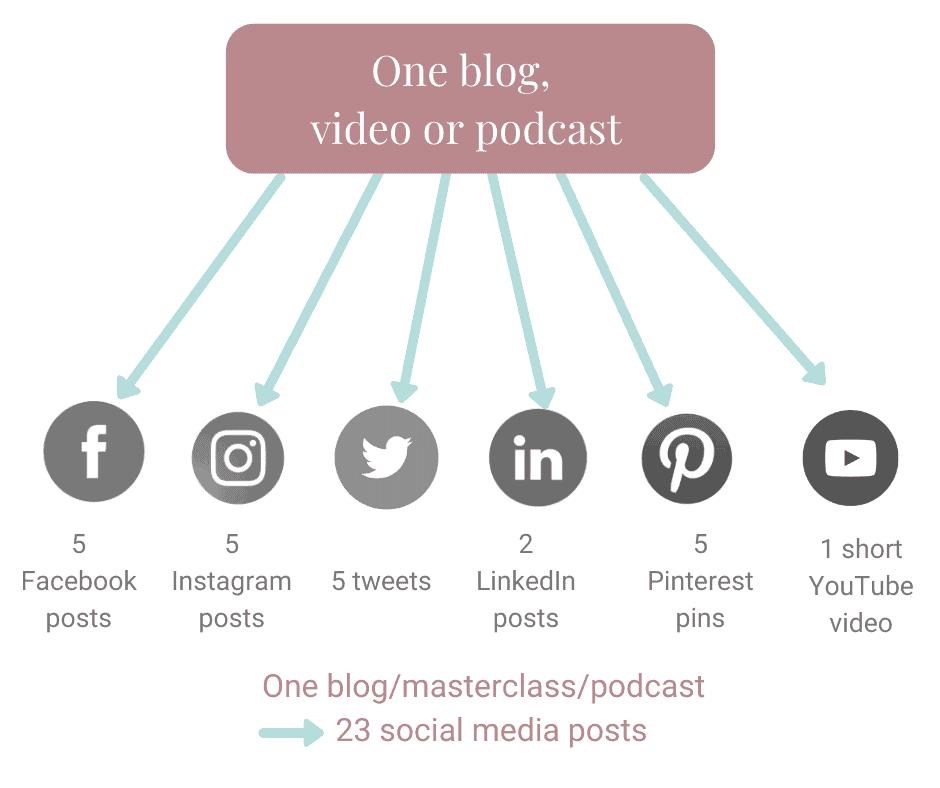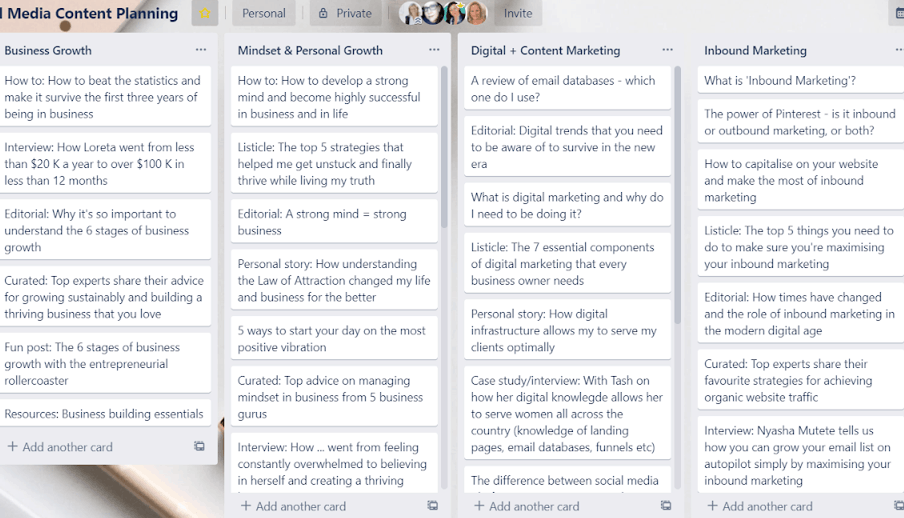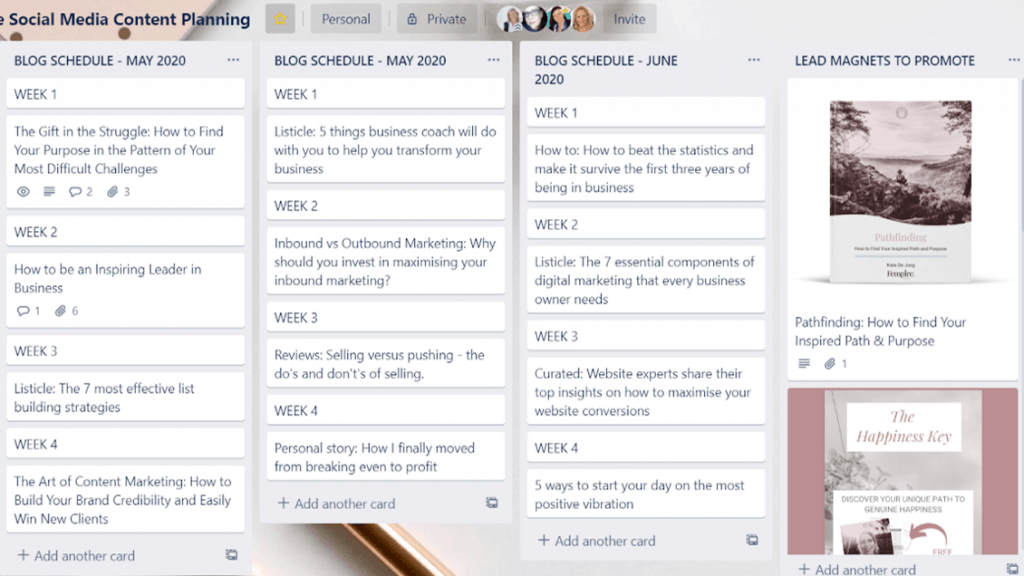Have you ever wondered how some businesses have the time. Also, energy to show up on social media with great content, consistently?
We used to wonder that too.
Back when we first started our business, several coaches advised that. We needed to “put ourself out there” and be posting on social media daily. As well as doing live videos at least once per week. So we dutifully started doing this, only to realise within a few months that this was all we are doing.
We didn’t have time to focus on anything else and we felt like it was spinning our wheels.
So much of time was taken up with:
- Trying to figure out what we are going to post about each day (and changing our mind countless times).
- Trying to figure out how we were going to talk about the topic. We finally chosen (and maybe change my mind one more time).
- Creating the content only to then, revise it, refine it, critique it, delete it, procrastinate. And finally pull something together to post.
- Spending half a day trying to record a five minute short video.
- Spinning our wheels with indecision and self-doubt.
Needless to say, this was all extremely time consuming. It was stressful knowing that we wasn’t spending any time doing the things required to actually grow my business like:
- Getting out and having real conversations with people.
- Following up with warm leads and getting them signed up into a coaching programs.
- Creating, testing, and refining the content for our coaching programs and offerings.
As a business owner, it can be so frustrating to be spending too much time on social media. Trying to market yourself, knowing you’re not spending enough time on client- and revenue-generating activities. A large part of this was a normal part of being a new business owner. And being new to social media and the world of ‘content creation’.
As a #business owner, it can feel so frustrating to be spending too much time on #socialmedia trying to #marketyourself, knowing you’re not spending enough time on client- and revenue-generating activities. #fempire Share on XBut the other major factor contributing to this never-ending. Pointless hamster wheel was a complete lack of organisation or strategic plan around my social media presence. If you’ve been in business a while, you’ll know that it’s critical to build trust. And confidence with your audience so that they feel safe spending their money with you.
The other major factor contributing to this never-ending, pointless hamster wheel was a complete lack of organisation or strategic plan around my social media presence.
You build credibility by:
- Creating compelling content to share your ideas and knowledge consistently (i.e. content marketing).
- Developing social proof so others know you’re credible (testimonials, reviews, awards etc).
- Building a network of brand advocates who spread the good word on your behalf.
And it’s point number one that we’re talking about here – Content Marketing.
So firstly, what is Content Marketing, and why should you bother doing it?
Content Marketing is the creation and sharing of digital information (blogs, videos, workbooks, social media posts etc.). To stimulate interest and build awareness of your products or services. It builds trust, credibility and confidence in your brand. Its purpose is to provide value to the customer, and ultimately to turn your followers into paying clients.
Content Marketing runs on the philosophy that you should provide free value to your customer. About 80% of the time (as a way of building trust and confidence). Then you pitch/sell your services around 20% of the time.
This is distinct from Direct Response Marketing, which is a sales technique designed to evoke an on-the-spot response. And encourages a prospective customer to take action on an offer being advertised (like all those Facebook and Instagram ads you see coming through all the time).
Direct Response Marketing uses paid advertising to deliver fast results. Content Marketing is free and takes longer to see results. But allows you to build up a catalogue of great content and followers while establishing you as a leader.
Since Content Marketing is free and gets results, why wouldn’t you apply it in your business?
Here are the benefits of Content Marketing – all for free!
- It builds brand awareness.
- It generates website traffic.
- It grows your email database.
- It gives you a competitive advantage.
- It increases client engagement.
- It generates leads and conversions.
There are 3 Main Types of Content
Content is any information you put out into the world to inform, educate or sell to your audience. There are different types of content as shown in the graphic below.
- Short form content (medium effort, more frequent).
This includes infographics (i.e. images that demonstrate a concept graphically, such as a health coach showing how gut nutrition works), short form blogs (400-600 words), or a short video (< 10 minutes). - Long form content (high effort, less frequent).
This includes things like longer blog posts (800-2000 words), long videos (30-60 minutes), or podcasts. They require effort and time to research and pull together. However, they demonstrate depth of thought and expertise. - Social media posts and curated content (low effort, frequent).
These are posts that contain an image and short text description or they can be content shared from other experts in your field (curated content).

So how do you implement a Content Marketing strategy. That allows you to be consistently visible, but doesn’t consume all your time?
You need to find a system that works for you and that you’re able to maintain long term. To build trust and confidence in your brand, consistency is key. How would you feel if your partner showed up for a week and then disappeared for three weeks? Your audience feels the same.
Consistency builds trust.
So how do you implement a Content Marketing strategy that allows you to be consistently visible, but doesn’t consume all your time?
7 Steps to Building Your Consistent Content Marketing Strategy
Hint: If you take the time to do the following exercises, they will transform your business!
1. Set Your Intention and Business Goals
There’s no point implementing any kind of marketing strategy. Without being crystal clear about what you want to achieve with it. How do you want your content marketing to serve you?
Our content marketing strategy has several goals:
- To grow email database consistently with 20 new warm leads per week.
- Generate 5 Free Business Strategy Sessions per week.
- Consistently build brand visibility, credibility, and awareness through weekly live videos and a consistent, high-quality social media presence.
Ask yourself what it is you want to achieve with your content strategy? And do you have the digital infrastructure in place to achieve those goals? If not, how will you implement it?
Be sure you have solid goals in place before you proceed.
2. Decide on a Content Strategy that You can Stick to Regularly
Consistency and leverage should be your key goals with any marketing strategy. If you create a blog post, be sure to get maximum leverage out of it. By creating multiple social media posts about your blog topic across all your different platforms. It’s also a good idea to create videos on your blog topic too.
Consistency and planning is key. Don’t commit to a frequency of content creation that you can’t keep up with and always plan in advance. #fempire #socialmediacontent Share on XHere’s the strategy that works for me (and works for many of my clients too).

You create one piece of long form content (per week, per two weeks, or per month, depending on the frequency you can commit to consistently). Then you turn that long form content into multiple social media posts. That can be scheduled out over time using a social media scheduling app like buffer or hootsuite.
We personally generate one piece of long form content every week. (But we also have a backlog of content now, that we can draw on and recycle if we don’t get time to create a new one).
As you can see in the image above, you can generate 23 social media posts to go out across your different social media channels. Just from that one piece of content.
We’re certainly not recommending you get across all of these different platforms (we usually recommend that you master 2-3 platforms first). But once you have a long form piece of content, it really isn’t too much work to turn those into short social media posts or videos. And once you start creating social media posts, there’s so much you can do. In fact, we’ve got 101 social media post ideas you can use right now!
So, what are you going to choose as the central piece of your long form content? A blog? A vlog? A podcast?
And which social media platforms are you going to focus on to leverage your long form content?
Write it down and commit to it. You might need to try several different strategies before you land on one that works for you and that you can stick to consistently. It took us several years to finally land on the strategy that we use now. Be prepared that this will be a process of trial and error initially. But commit yourself to finding what works for you!
3. Determine the Frequency of Content Creation
Now you know how you’re going to approach your content marketing. You need to figure out how often you’re going to create your original content and the leveraged posts that you create from that content.
Here’s what you need to do:
- Decide how often you can commit to creating one long form piece of content.
Will it be once per week? Once per month? - Decide how many social media posts you want to create from your single piece of long form content.
To leverage your long form content, you should generate at least 4-6 social media posts from one blog/video/podcast. - Determine your frequency of social media posting based on your content creation frequency.
For example, if you only blog/vlog once every two weeks. And you only want to create 6 social media posts from that content. You’ll be able to schedule your posts to go out every 2-3 days.
Now that you have a plan to follow and a frequency to stick to. You can get busy creating your content on a consistent basis! Once you have your content plan in place, you then need to create a database of content ideas that you can draw from.
Once you have your content plan in place, you then need to create a database of content ideas that you can draw from. #fempire #contentmarketing Share on X4. Develop Your Ideas Database: Determine Your Content Categories
When you’re not clear about what you need to write or post about. It’s easy to get into procrastination and time wasting (We are sure you can relate). A game changing strategy for us has been to develop a large database of topics and ideas for our blogs. That we can choose from and plan out for each month. So that you never have to worry or think about what your going to write about.
Here’s how you can easily develop a huge database of content topics and ideas.
Choose how you’re going to break down your business into different umbrella categories.
For example, for business coaching, my categories are as follows:
- Business Strategy & Growth
- Mindset & Personal Growth
- Marketing & Selling
- Websites
- Social Media
- Time Management & Productivity
What are yours?
5. Develop Your Ideas Database: Use Content Multipliers to Expand Each Category into Multiple Topics
Once you have your categories, it can still be difficult to break it down into multiple posts. This is where ‘content multipliers’ come in extremely handy, which are different ways to present the same or similar content, or at least help you generate ideas to maximise your content.
Different types of content multipliers you can use:
- How to’ article: Tutorials or walk-throughs, e.g. How to Build Your Email Database.
- Listicle: List-based articles, e.g. 5 Apps that will Help You Easily Streamline Your Business Processes.
- Editorial: Standard type of blog post, e.g. The 6 Stages of Business Growth.
- Curated: A list that brings together great content from other influencers in your niche, e.g. 10 Books that Every Business Owner Needs to Read.
- Interview: Interviews with clients, colleagues or other leaders in your industry (e.g. How Natasha built her six figure business within twelve months).
- Personal Story: Write about your personal experiences, e.g. How I grew my email database from 50 to 2,000 in six months.
- Case Study: Write about a client’s experience or journey e.g How Kellie & Abbie Started Their Business at Just 7 Years of Age.
- Fun post: A post with the goal being to entertain, e.g. My favourite 10 social media ‘faux pas’.
- What post: A post that explains a concept, e.g. What is a Profit & Loss Statement?
- Why post: A post that explains the importance of a concept, e.g. Why you need to understand the six stages of business growth.
- Resources: Create a list of helpful resources, e.g. My favourite five books to help you master your money mindset.
- Reviews: Write a review on a particular product or service, e.g. A Review of the Best Email Database Managers.
- News-jacking: Leverage a news-worthy topic that people in the industry are talking about, as long as it relates to your audience e.g. How Fempire has Pivoted to Survive the COVID-19 Crisis.
6. Develop Your Ideas Database: Create a Matrix to Map Out Your Topics
Use the content multipliers above to create 10+ topics for each of your content categories and then get those ideas into a matrix.
We love to use Trello for this, as it’s a great way to capture, store, and organise your ideas while also giving you the flexibility to easily change or move things around if you change your mind (as we do all the time). An excel spreadsheet or Google Sheet will also do the job fine.
Below is a screenshot of my Topic Database stored in a Trello board where I map out my topics using the content multipliers.
This means we never run out of ideas to blog about!

7. Schedule Out Your Topics so You Know Exactly What You’ll be Writing About, and When
Now that you have a database of content topics to draw from, you can schedule out when you’re going to create a long piece of content for each one of them.
As mentioned, we create one blog post per week, which I then turn into 3-4 social media posts one each platform (which means I’m posting every second day).
Once you’ve created the blog article, you store the blog link in a Trello card and attach the social media images to go with it too. That way you can schedule out the social media posts straight from Trello.

8. Block Time in Your Calendar to Prepare Your Content
It’s all well and good to map out a content calendar, but if you don’t block the time in your calendar to create the content, it will never happen!
The most effective way to create content without letting it take over your life is to batch your time. Which means scheduling time in your calendar to create all your content in one sitting.
We work on a weekly basis, so we spend half a day each week preparing and scheduling our content (We’re very fortunate now having a Virtual Assistant to help us with the scheduling, but for years we did it yourself!).
We highly recommend that you block at least half a day each week to create your content (if you create content weekly), or block out a whole day or two days each month if you like to prepare a whole month’s worth of content. Please don’t try to prepare your content on the fly, this is ineffective and time-inefficient. You must get into the habit of batching your time and preparing all your content in one sitting. This is how you escape the trap of spending all your time on social media and not having time to spend on growing your business.
Don’t try to prepare your #content on the fly, this is ineffective and time-inefficient. Get into the habit of batching your time and preparing all your content in one sitting. This is how you escape the trap of spending all your time… Share on X9. Schedule Your Prepared Content
Now that you’ve prepared your content (your blog/vlog/podcast and all your social media posts and videos), you can schedule them out to go out consistently over the period of time you’ve chosen.
Our favourite scheduler is Hootsuite because you schedule across all the different social media platforms (including LinkedIn), and they provide you with a dashboard so that you can see a clear overview of where and when your content is going across the different platforms. You can move scheduled posts around or spread them out to get an even, consistent presence in the way you want.
10. Review and Refine Your Content Marketing Strategy
You’ll have to monitor how your marketing strategy is working and whether the quantity of work required is manageable for you. As we mentioned, it took us a long time of trial and error to find a strategy that we could implement consistently.
Make your content deadlines non-negotiable, and watch how your leads start to grow.
If you’d like to talk through different options for your business, please reach out. As we said many times, commit to showing up consistently! Make your content deadlines non-negotiable, and watch how your leads start to grow.
Thank you for reading!
What’s your favourite part of content marketing? Let us know in the comments below! xox

This was written by one of our talented team members. Head to our About Fempire page to learn more about what Fempire does and how you can join the sisterhood. And don’t forget to follow us on Facebook, Instagram, LinkedIn, Youtube, or Pinterest by clicking the buttons below.





This was just what I needed, thankyou!
You’re so welcome Elle-May, so glad it helped you!
Kate x
Thank you so much for sharing your wisdom, this is a game changer.
Glad you enjoyed the article Sanjukta! xx
Ah I’m so glad Sanjukta! X